List of Contents
What is the Aerogel Market Size?
The global aerogel market size is valued at USD 1.68 billion in 2025 and is predicted to increase from USD 1.95 billion in 2026 to approximately USD 6.54 billion by 2034, at a CAGR of 16.34% from 2025 to 2034. The North America aerogel market size reached USD 680 million in 2024. The increasing demand for aerogel in the various end-use industries is driving the growth of the market.
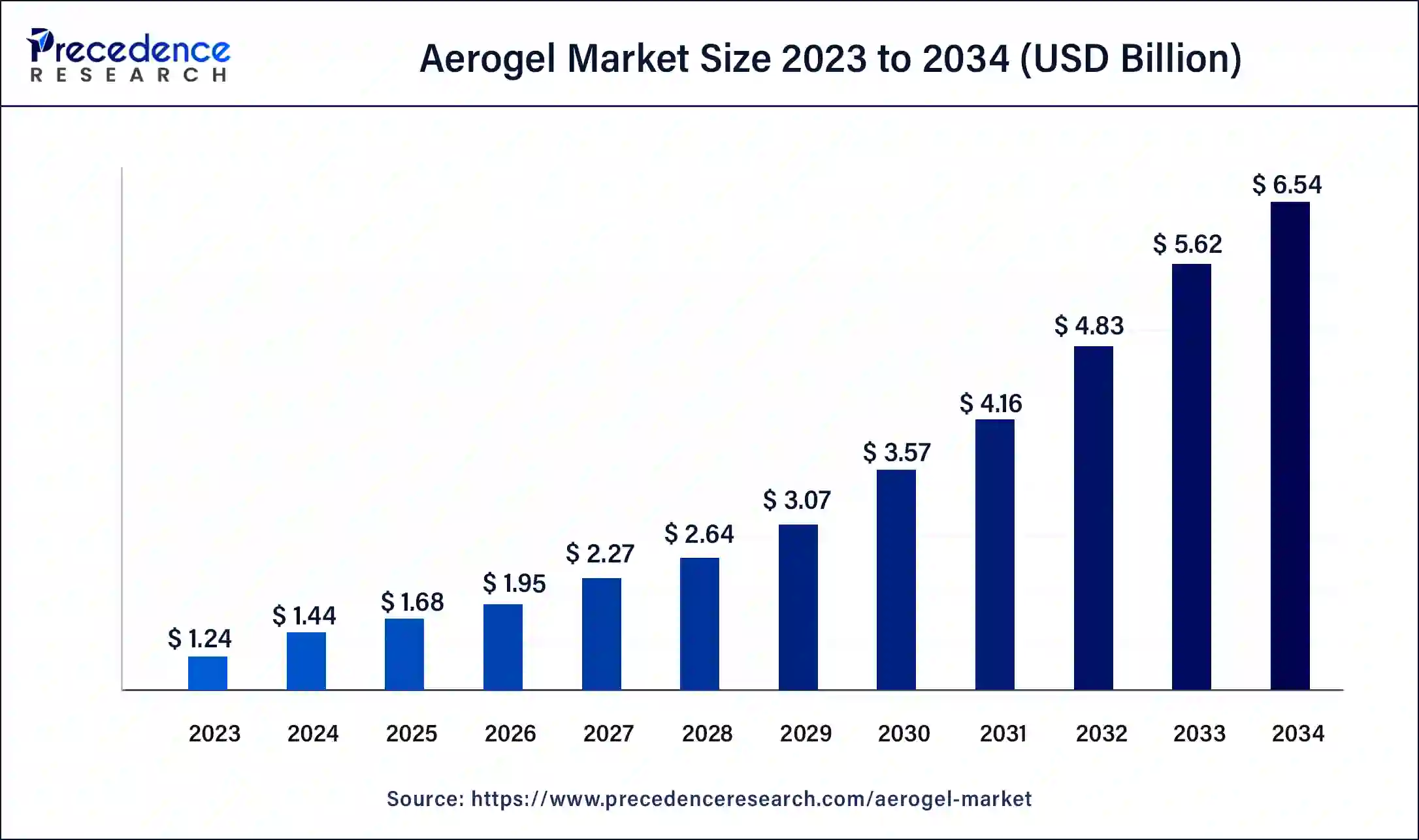
Aerogel Market Key Takeaways
- The global aerogel market was valued at USD 1.44 billion in 2024.
- It is projected to reach USD 6.54 billion by 2034.
- The aerogel market is expected to grow at a CAGR of 16.34% from 2025 to 2034.
- North America dominated the market with the largest market share of 47% in 2024.
- By product, the silica segment contributed more than 67% of market share in 2024.
- By product, the carbon segment is expected to grow at a solid CAGR of 19.43% during the forecast period.
- By technology, the supercritical drying segment generated the highest market share of 74% in 2024.
- By form, the blanket aerogels segment dominated the market in 2024.
- By form, the aerogel panel segment is projected to expand at a double Digit CAGR of 20.72% during the forecast period.
- By end-use, the oil & gas segment recorded more than 64% of market share in 2024.
- By end-use, the building & construction segment is expected to grow at a double digit CAGR of 17.11% during the anticipated period.
Market Overview
The aerogel is an extremely lightweight, porous, solid component made by replacing liquid in gel gas without impacting its original size, shape, or structure. Aerogel can be derived from a number of chemical compounds, such as silica and polymer-based aerogel. These aerogels are derived from the extraction of liquid components with the use of technologies like freeze-drying and supercritical drying.
Aerogel is a pressing soft material. Despite it being a rigid, dry, and solid material, it does not leave any mark on it. The aerogel material consists of 50% to 99.98% of the air by its volume and exhibits 90% to 99.8% of the porosity. Aerogel has great thermal insulation and conductivity, which makes it the ideal material for building, industrial construction, and clothing insulation, driving the growth of the aerogel market.
How Can AI Impact the Aerogel Market?
Artificial intelligence is transforming the landscape of the aerogel used in the industries. A number of leading technologies are adopting AI, robotics, and other advanced technologies in the designing of sustainable aerogel material in wearable technologies. The aerogel materials are lightweight and have higher thermal insulation than the other insulation materials, making it easy and efficient to use the aerogel in wearable technology.
- In July 2024, University of Maryland (UMD) engineers developed the integrated model with collaborative robots and machine learning led by Po-Yen Chen, assistant professor in UMD's Department of Chemical and Bimolecular Engineering, to address the challenges in the design of materials used in the wearable green technology.
Aerogel Market Growth Factors
- The rising presence of the end-use industries such as automotive, construction and buildings, manufacturing, pharmaceutical, defense, and others are driving the growth of the aerogel market.
- The increasing demand for low-density materials with higher thermal isolation properties in the various end-use industries is boosting the demand for the market.
- The rising concern among manufacturers for aerogel and its properties with other insulation materials is driving the implementation of aerogel in the industries and driving the growth of the market.
- The rising government initiative to fund research on the evaluation of aerogel and its potential usage in various industries is driving demand for aerogel in the various industrial applications that drive the growth of the market.
- The rising technological adoption in expansion in the use of aerogel in industrial use and the adoption of technologies like supercritical technology and others are effectively contributing to the increased use of aerogel in different applications, driving the growth of the aerogel market.
Aerogel Market Trends
- In April 2024, Empa Researchers successfully developed the green advantages of 3D printing, biodegradable material, and ultra-light aerogels in a single cellulose-based 3D printable material.
- In September 2023, Hyosung, a Seoul-based textile company, launched the Creora Spandex with higher availability of renewable resource content that helps minimize the yarn's carbon footprint.
- In December 2023, Hyosung, a leading fiber producer, is focusing on the development of alternatives to synthetic materials for the textile industry.
Aerogel Market Outlook
- Industry Growth Overview: Between 2025 and 2030, this market is expected to rise significantly due to the growing demand for high-quality silica compounds from the coatings industry coupled with technological advancements in the aerogel sector.
- Major Investors: Numerous aerogel companies are actively entering this market, drawn by collaborations, R&D and business expansions. Numerous market players such as Cabot Corporation, Dow, Inc., Aspen Aerogels, Inc., and some others have started investing rapidly for developing high-quality aerogel for end-user industries.
- Startup Ecosystem: Various startup companies are engaged in developing aerogels for end-user industries. The prominent startup brands dealing in manufacturing aerogel solution comprises of Blueshift Materials, OROS, Graphene Composites and some others.
Market Scope
| Report Coverage | Details |
| Market Size by 2034 | USD 6.54 Billion |
| Market Size in 2025 | USD 1.68 Billion |
| Market Size in 2026 | USD 1.95 Billion |
| Market Growth Rate from 2025 to 2034 | CAGR of 16.34% |
| Largest Market | North America |
| Base Year | 2024 |
| Forecast Period | 2025 to 2034 |
| Segments Covered | Product, Technology, Form, End-Use, and Regions |
| Regions Covered | North America, Europe, Asia-Pacific, Latin America, and Middle East & Africa |
Market Dynamics
Driver
The increased use of aerogel in the automotive industry
The automotive industry is rapidly expanding, and continued research on the development of new technology, materials, and other advancements for expanding the efficiency and performance of the vehicles are contributing to the adoption of the new technologies and materials that are driving the implementation of aerogel in the automotive sector. The aerogel can be used in the designing and manufacturing of both conventional and electronic vehicles. Aerogel plays an important role in vehicles; it reduces the potential risk of fire, heat preservation, and heat insulation and abstracts the higher noise by the vehicle.
The aerogel works as the firewall or the heated wall between the engine and the passenger compartment, though it reduces the heat emitted by the engine to the passenger compartment. The aerogel has several beneficial properties, such as great insulation, thin thickness of heat insulation layers, higher performance, and lower thermal conductivity that improves the performance of the vehicle. It has waterproof properties that promote longer service life, and it is the most toxic-free material that creates no negative impacts on the environment.
Restraint
High cost
The increased cost of aerogel and its raw materials in the manufacturing process is limiting the adoption of aerogel as the insulation material in the different applications that restrain the growth of the aerogel market.
Opportunity
Advancements in aerogel applications
Aerogel materials have several beneficial properties that make them an ideal choice for industrial applications. Industries like space research and the leading space research firm NASA have used aerogel as the thermal insulation material in designing space suits and trapping cosmic dust particles in Stardust Spacecraft.
Product Insights
The silica segment dominated the aerogel market in 2024. The silica aerogel is the most common type of aerogel; it is made from the extraction of liquid from the silica gel. The silica gel is generally produced from the sol-gel process. The rising demand for silica gel is due to its efficient chemical properties, which can be used in a wide range of technological applications. These types of aerogels are nanostructured materials with higher porosity, minimized dielectric constant, density, and great heat insulation.
The silica gel is also used in space or cosmic applications; it is used by space organizations such as NASA to capture cosmic or space dust. The silica aerogel is lower in mass, which makes it ideal for trapping space dust.
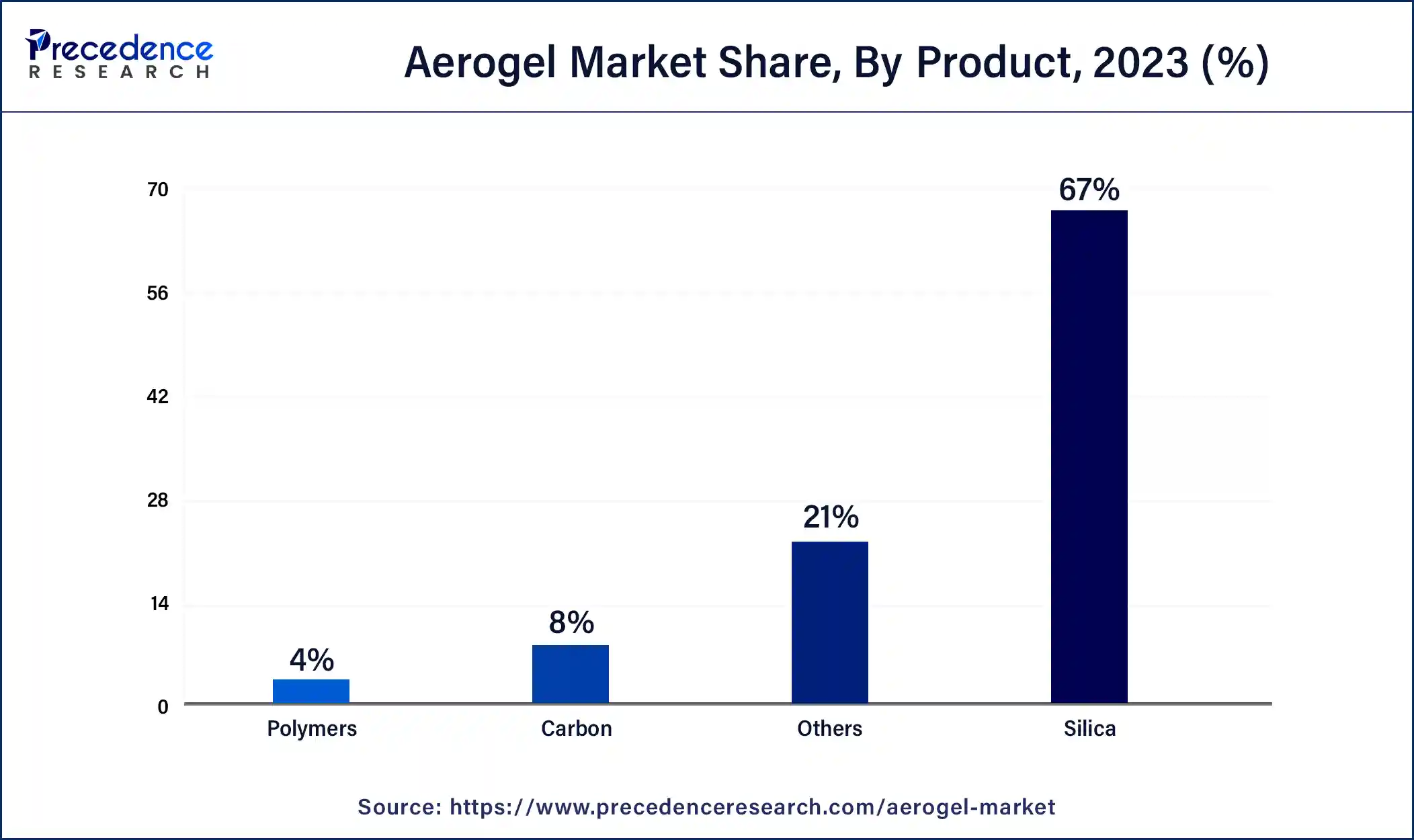
The carbon segment is expected to grow significantly in the aerogel market during the forecast period. The rising use of carbon aerogel in various electrical applications such as supercapacitors, fuel cells, and desalination systems. This type of aerogel is the lightest material on earth, with the lowest density. The carbon aerogel is a porous material combined with carbon nanoparticles. The carbon aerogel has the highest electricity conductivity and higher surface area. Due to the higher electric conductivity, it is used in a wide range of electrical applications, which drives the demand for the segment.
Technology Insights
The supercritical drying segment led the aerogel aerogel market in 2024. Supercritical drying is the technology that is used to replace the liquid material with the gas isolate. Supercritical drying is also called supercritical extraction, critical point drying, and supercritical lyophilization.
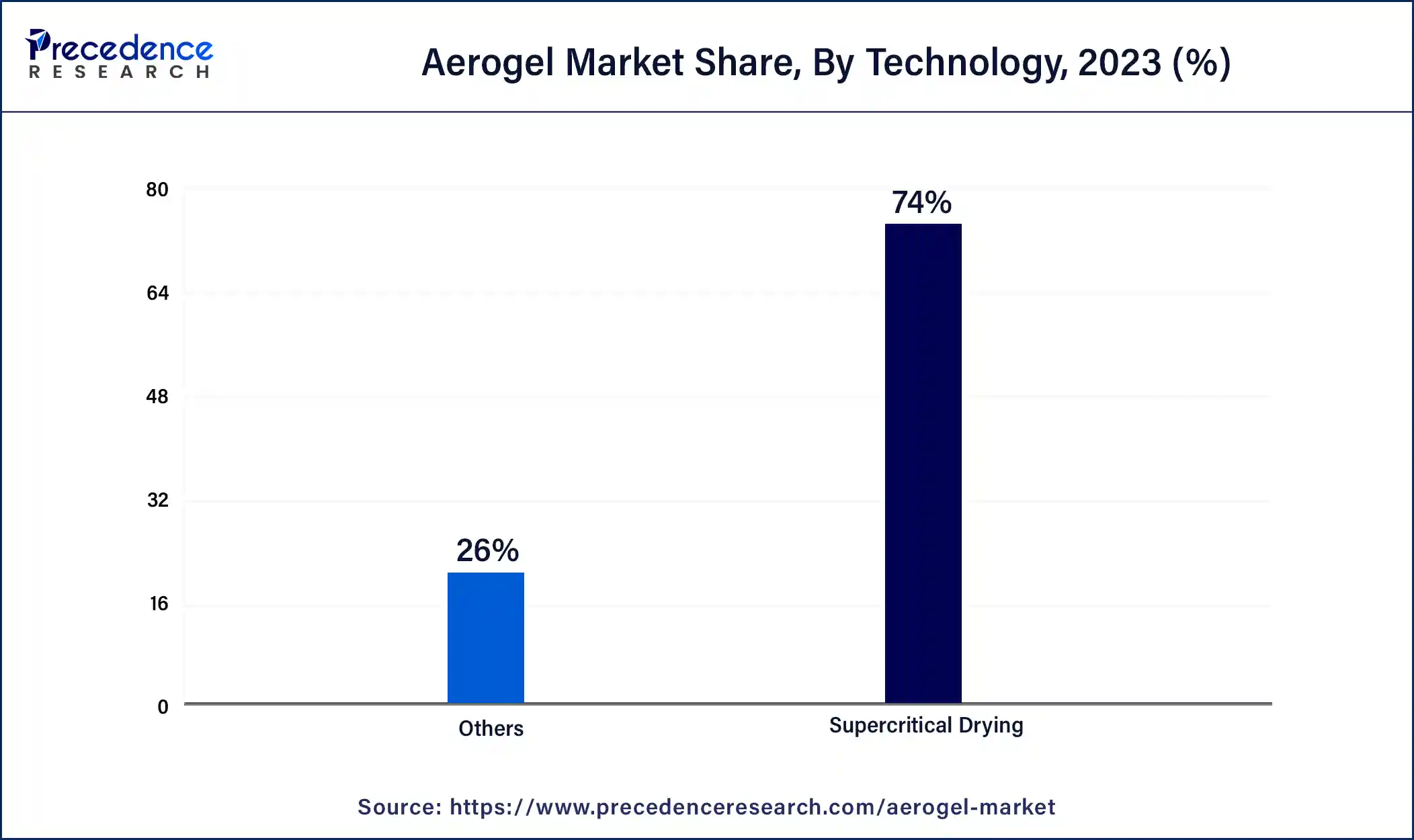
Supercritical drying leads to specific characteristics in the aerogel, like low density, higher porosity, and large surface area. It is the process or technology that extracts the solvent from the pores of aerogel, which is also known as the efficient technology in drying wet gels. There is an increasing demand for supercritical drying in laboratory drying units.
Form Insights
The blanket segment dominated the aerogel market in 2024. Blanket aerogel is equipped with great insulation properties, though it is increasingly used as an insulation material in buildings and clothing. The growing demand for blanket aerogel is due to its higher beneficial properties such as water repellency, high breathability, low powdering and low dusting, and light diffusion. Thus, the rising construction activities and the rising use of blanket aerogel in buildings and industries to maintain safety standards are driving the demand for the blanket aerogel segment.
The panel segment is projected to grow significantly in the aerogel market during the forecast period. The growth of the segment is attributed to the rising adoption of aerogel panels in several applications in the construction, defense, and other industrial sector due to their higher thermal conductivity, easy handling, and hydrophobicity. The aerogel panels are also used in various electric applications.
End-Use Insights
The oil & gas segment dominated the aerogel market in 2024. Aerogels are highly in demand in the oil and gas industries due to their efficient properties such as higher thermal insulation, conductivity, hydrophobicity, mechanical strength, and other properties that make aerogel an ideal material for wide applications in the oil and gas industry such as it used in the construction of the deep underwater pipes and oil and gas piping.
It reduces the requirement for steel and other materials in the pipeline, which reduces production costs, reduces corrosion in the pipeline, and expands the life of the pipe. Aerogel is efficiently used to address a number of challenges, including the thermal insulation of equipment and pipelines; it is widely used in gas separation and absorption of oil leakage.
According to recent study, “Oil and Gas Industry Annual Contracts Analytics by Region, Sector (Upstream, Midstream, and Downstream), Planned and Awarded Contracts, and Top Contractors,” the entire contract associated with the oil and gas industry is increased to $183.63 billion in 2022 from $178.86 billion in 2021. The contract volume saw a slight reduction from 6,972 in 2021 to 6,668 in 2022.
The building & construction segment is expected to have significant growth in the aerogel market during the anticipated period. The aerogel is largely adopted by the construction sector for the thermal insulation of building and industrial units. Aerogel is used in various forms, such as panels, boards, blankets, and renders, to maintain the strength, integrity, and authenticity of heritage buildings. A number of major construction sector players have adopted aerogel for thermal insulation in buildings to maintain safety standards.
Regional Insights
U.S. Aerogel Market Size and Growth 2025 to 2034
The U.S. aerogel market size is exhibited at USD 630 million in 2025 and is projected to be worth around USD 2,500 million by 2034, poised to grow at a CAGR of 16.56% from 2025 to 2034.
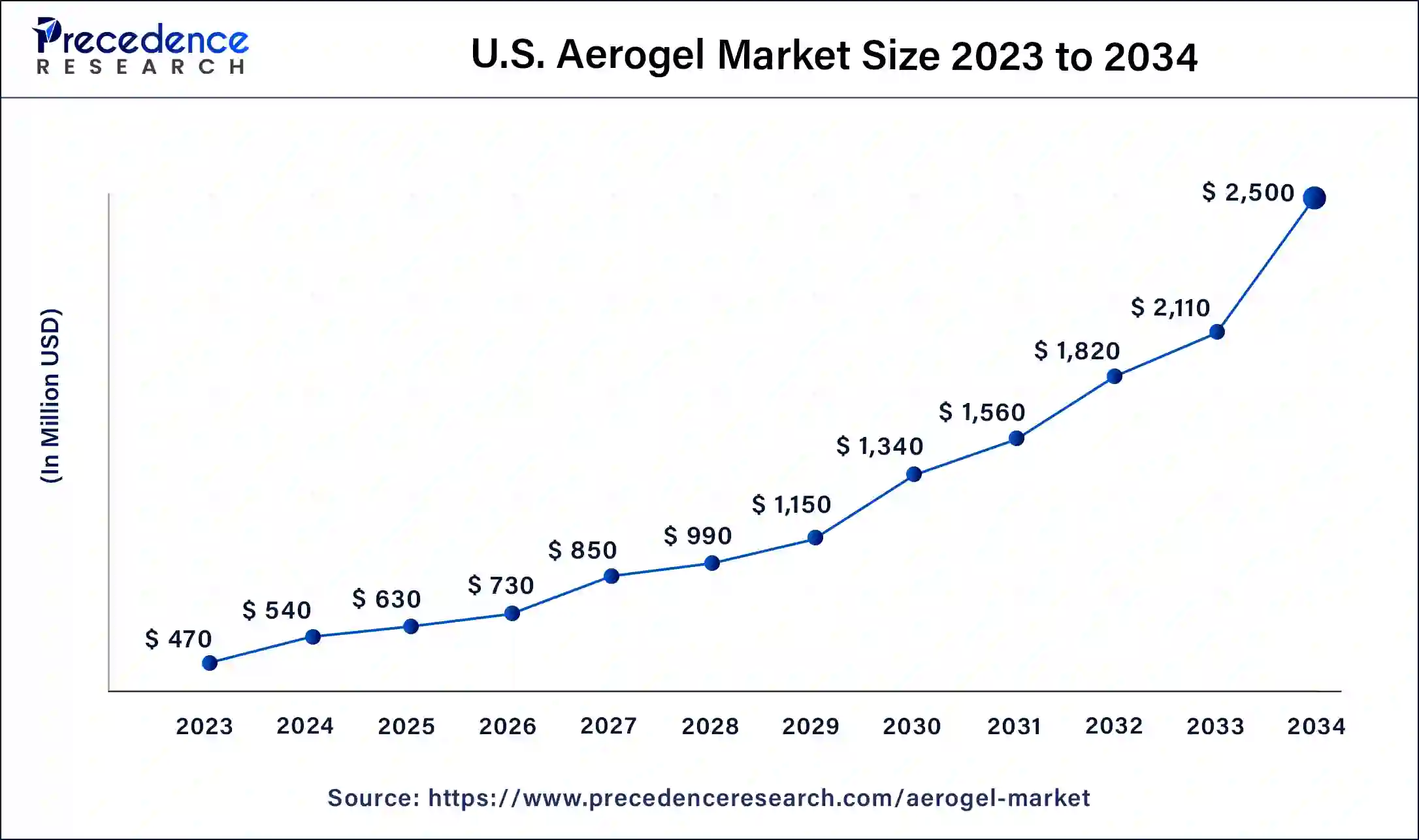
North America dominated the aerogel market with the largest market share in 2024. The growth of the market is attributed to rising industrial development and the increasing availability of end-use industries such as construction, automotive, energy, electronics, and others, which are driving the demand for aerogel. The rising investment by the public and private firms in industrial development and maintaining safety standards in the industries are driving the growth of the aerogel market in the region.
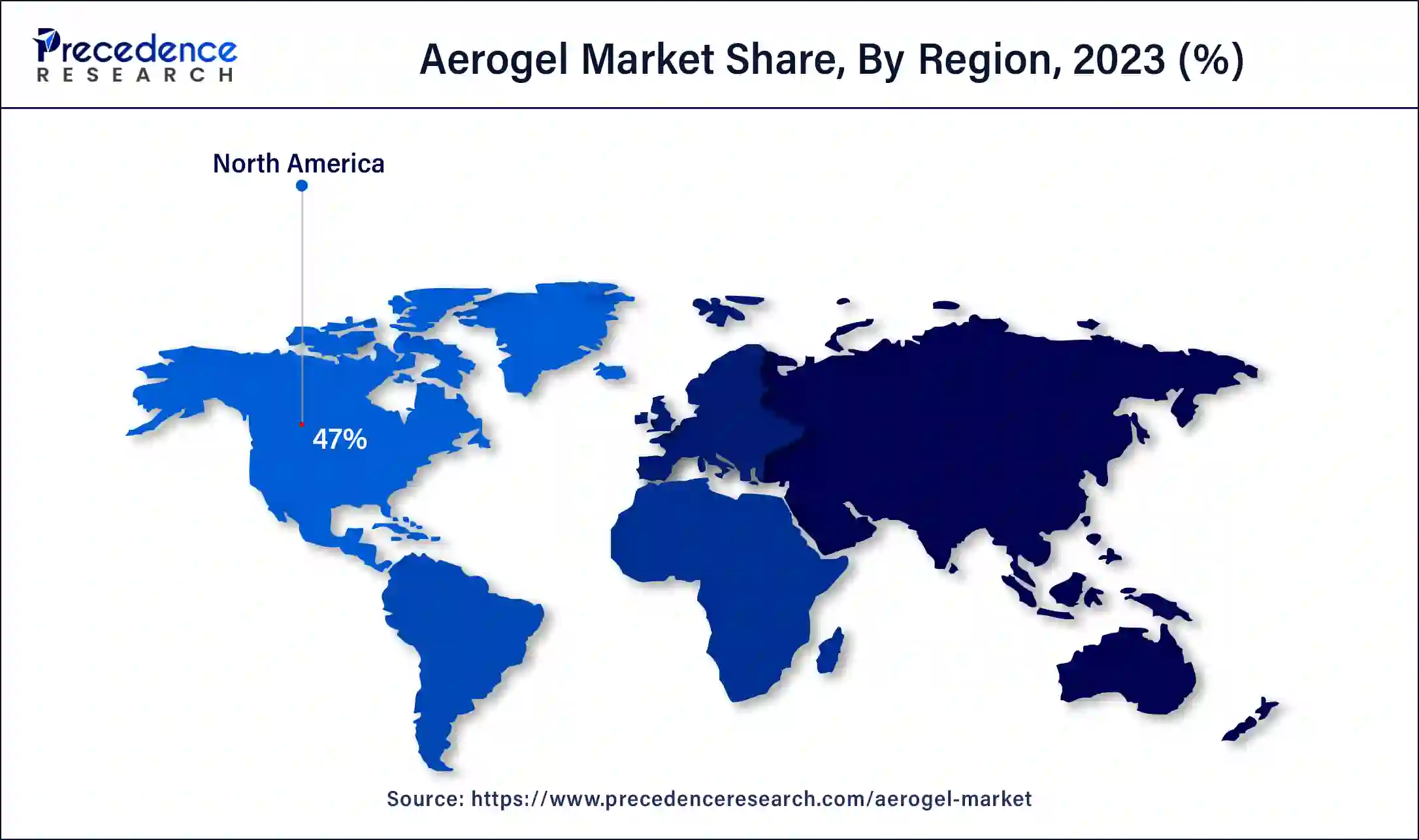
- The increasing use of insulation material in the United States residential and commercial buildings saves loads of energy and cost in the cooling and heating of buildings. The use of insultion also helps in reducing greenhouse gas emissions in the environment.
- The manufacturing of insulation material in the United States is a $24.9 billion industry that directly employs more than 40,000 people from 45 states. Furthermore, insulation manufacturing employs 73,000 jobs in the supply chain industry.
- The integrated economic activity in the U.S., supported by the manufacturing of insulation materials, has contributed over $2.4 billion to local and state governments and $3.3 billion in federal tax revenue.
Why Asia Pacific is a prominent contributor of the aerogel market?
Asia Pacific is a prominent contributor of the industry. The rise in number of residential constructions in prominent countries such as India, China, Japan, South Korea, Australia and some others has boosted the market growth. Additionally, rapid expansion of the marine sector coupled with technological advancements in the painting industry is expected to boost the growth of the aerogel market in this region.
What led Europe to hold a significant share of the aerogel market?
Europe held a significant share of the market. The surging emphasis of automotive and aerospace brands to adopt aerogels in various countries including Germany, France, Netherlands, Italy and some others has propelled the market expansion. Also, rapid investment by market players for opening up new manufacturing plants to increase the production of aerogel is expected to proliferate the growth of the aerogel market in this region.
What made Latin America to hold a considerable share of the aerogel market?
Latin America held a considerable share of the industry. The growing demand for silica from the performance coatings industry in numerous nations such as Argentina, Brazil, Venezuela and some others has boosted the market growth. Additionally, several government initiatives aimed at developing the road infrastructure is expected to accelerate the growth of the aerogel market in this region.
How did Middle East and Africa held a notable share of the aerogel market?
Middle East and Africa held a notable share of the market. The increasing demand for high-quality aerogels from the oil and gas industry across numerous countries such as Saudi Arabia, UAE, South Africa and some others has driven the market expansion. Also, rapid investment by startup companies to manufacture a wide range of aerogels is expected to drive the growth of the aerogel market in this region.
Value-Chain Analysis
- Raw Material Procurement
The main raw materials for aerogel production are silica precursors including tetraethoxysilane (TEOS) and methyltrimethoxy-silane (MTMS) for traditional silica aerogels, as well as organic polymers such as cellulose, chitin, and proteins for biopolymer aerogels.
Key Companies: Muby Chemicals, Otto Chemie Pvt. Ltd., SiSiB Silicones and others. - Testing and Quality Control
Quality control (QC) and testing of aerogels involves a range of techniques to measure their unique properties, such as low density, high porosity, low thermal conductivity, and mechanical strength.
Key Companies: Aspen Aerogels, Cabot Corporation, Jios Aerogel and others. - Distribution Channel
The distribution channels for aerogel primarily involve direct sales to large industrial clients and distributors for broader market access.
Key Companies: JIOS Aerogel Corporation, BASF SE, Nano Technology Co., Ltd. and others.
Key Players: Manufacturing aerogel for end-users
- Nano Technology Co., Ltd.: Nano Tech Co., Ltd. was established in 2004, that deals in the R&D and production of silica aerogel and its composites for insulation. This company specializes in nanomization technology, developing and selling high-performance materials and carbon nanotube dispersions.
- Dow, Inc.: Dow, Inc. is a global materials science company, headquartered in Midland, Michigan, that produces and supplies a wide range of chemicals, plastics, and silicones. Its products are used in numerous applications ranging from consumer goods and packaging to infrastructure and automotive.
- Aspen Aerogels, Inc.: Aspen Aerogels, Inc. is a technology company that designs, develops, and manufactures advanced aerogel insulation materials for industrial, commercial, and electric vehicle (EV) markets. The company's products are used for energy conservation, thermal management, and safety applications.
- Cabot Corporation: Cabot Corporation is a global specialty chemicals and performance materials company headquartered in Boston, Massachusetts. This company develops and manufactures advanced materials including carbon black, activated carbon, and fumed metal oxides, which are used in a wide range of applications such as tires, construction, electronics, and printing.
- Aerogel Technologies, LLC: Aerogel Technologies, LLC is a company that develops and manufactures advanced aerogel materials, particularly its proprietary Airloy Ultramaterials, that are lightweight, strong, and super-insulating. This company serves a wide range of industries such as aerospace, automotive, and construction.
- Active Aerogels, LDA: Active Aerogels, LDA is a Portuguese company founded in 2013 that develops and manufactures aerogels for thermal insulation and filtration applications. The company, based in Coimbra, serves diverse markets including oil & gas, aerospace, and wastewater treatment.
- Enersens: Enersens is a French deeptech company founded in 2010 that specializes in the research, development, and production of silica aerogel-based super-insulation products. This brand's goal is to democratize super-insulation through innovative industrial processes that make silica aerogel more affordable and accessible.
Aerogel Market Companies
- BASF SE
- JIOS Aerogel Corporation
- Nano Technology Co., Ltd.
- Dow, Inc.
- Aspen Aerogels, Inc.
- Cabot Corporation
- Aerogel Technologies, LLC
- Active Aerogels, LDA
- Enersens
Recent Developments
- In April 2024, SA-Dynamics, a German start-up company, launched bio-based aerogel insulation with the use of 100% bio-based aerogel fibers. The company aims to transform the construction by completely replacing fossil-based aerogel with bio-based aerogel.
- In May 2024, Outlast Technologies launched the latest Aersulate aerogels based on aramid fibers that drive new opportunities in different applications. The aramid fibers aerogel are pressure and moisture-resistive; it is a thin and flame-resistant material.
- In August 2025, Outlast Technologies launched Aersulate. Aersulate is an aerogel-based fabric designed for the textile industry.
(Source: https://kohantextilejournal.com ) - In June 2025, Armacell announced to open a new production facility in India. This manufacturing unit is inaugurated to increase the production of an aerogel named as ‘ArmaGel'
(Source: https://www.pressebox.com ) - In June 2025, Alkegen launched AlkeGel. AlkeGel is an aerogel insulation designed to enhance electric vehicle battery safety.
(Source: https://emobilityplus.com )
Segments Covered in the Report
By Product
- Silica
- Polymers
- Carbon
- Others
By Technology
- Supercritical Drying
- Others
By Form
- Blanket
- Particle
- Panel
- Monolith
By End-Use
- Oil & Gas
- Building & Construction
- Automotive, Aerospace & Marine
- Performance Coatings
- Others
By Geography
- North America
- Asia Pacific
- Europe
- Latin America
- Middle East & Africa
For inquiries regarding discounts, bulk purchases, or customization requests, please contact us at sales@precedenceresearch.com
Frequently Asked Questions
Ask For Sample
No cookie-cutter, only authentic analysis – take the 1st step to become a Precedence Research client